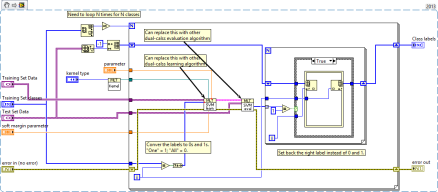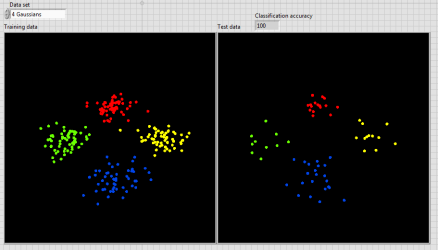As I mentioned in the last post, I am now studying machine learning in my new position. Today I came across a problem to use SVM to do multiclass classification. The toolkit (link) downloaded from NI did not provide the ability to do multiclass classification with SVM but only for two classes (it’s quite a useful tool still). So I took use of the SVM VIs and made a multiclass version using one-vs-all method.
There is a good tutorial on one-vs-all or one-vs-rest classification by Andrew Ng (link). So basically we pick one class each iteration as Class A and make the rest classes as Class B. Only the test data that locate in Class A are allocated to the known class. Here is the code:
The original trained labelled data are classified as Class 0, 1, 2, … N. In the i-th iteration, only the data from Class i are re-classified to Class 1 and the rest data are re-classified to Class 0. When the test data locate in class 1 area, they are classified as Class i. Any unsorted data are left in Class -1. When I test the performance of this one-vs-all classifier, the result seems fine 🙂
The code is not optimized and the execution may cost a while.


Hello Dr. Fu
Thanks for the explanation and sharing the code. I have a small doubt. According to Andrew Ng’s video, if there are N classes, N classifiers have to be trained and hence for a particular test data we receive N classifications and we must choose the classification with the highest probability. However, in your implementation, the maximization of the probability is missing. I think your implementation will work fine so long as you do not have outliers in your test data. If you have outliers two or more of the classifiers may give a false positive result and in that case it becomes important to look at the probability. Please correct me if I am wrong.
Thanks.
Biswarup Mukherjee
Hello Doctor
Good Night from my side
I am just starting with SVM, so I was thinking in how could I introduce data set to SVM code, actually the dataset is about acceleration signal (.txt)
If you could help me I’d be so thankful
sincerely
Elo
Have a good day
Regards